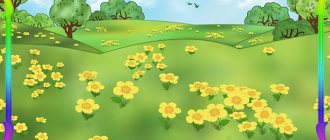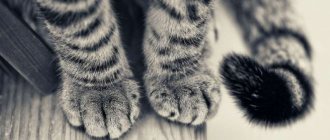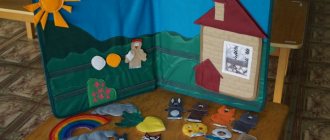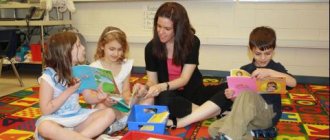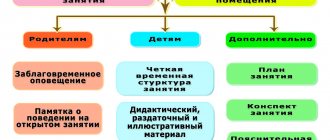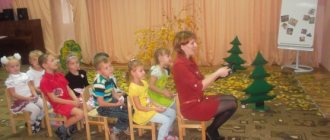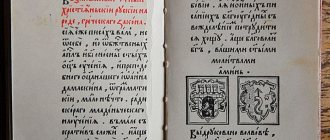Summary of a rhythm lesson in the preparatory group
Summary of a rhythmic lesson in the preparatory group “Multi-colored caps”
Author: Olesya Olegovna Adashkevich, additional education teacher, Municipal Autonomous Preschool Educational Institution No. 169 “Combined Kindergarten”, Kemerovo, Kemerovo Region
Purpose of the lesson:
development of the motor sphere of children, formation of spatial orientation skills, development of imagination and the ability to motor improvisation.
Tasks:
1. Develop spatial orientation skills. 2.Develop attention, memory, creative imagination. 3.Overcome motor automaticity. 4.Develop the visual and motor response of children to light, verbal, visual signals. 5. To foster children’s independence in performing exercises Equipment: tape recorder, piano, audio cassettes with recordings, flashlights, cards with diagrams, sun mat, chest, gnome hats. Children's musical instruments: bells, rattles, bells, maracas
Progress of the lesson:
Children enter the hall to the music and stand in two columns - boys and girls. Greetings and bows. Teacher. Today I invite you to go to a fairy tale. Now you and I will fly to the music. If the music stops, it means there is some kind of obstacle on the way. You will see the diagram and line up the same way.
Exercise on rearranging in space
Children move loosely in accordance with the musical accompaniment (light running, jumping). With the end of the music, they are built in accordance with the diagram (circle, column, 2 circles, 2 columns) Teacher. Guys, look, we are visiting some fairy-tale characters. I will help you. Listen to the riddle. The rainbow has exactly seven colors, And music has seven notes, Well, in this fairy tale there are seven different gnomes. But look, there are no gnomes, only their caps are here. Yes, they are all different colors! Why do you think? (probably because gnomes have different personalities) Oh, and there’s a note here. Reads: “Our caps are magical. If you put the cap on, you can find out who its owner is. Only the one who eats the magic candy can find out what the caps say.” Since there is only one candy, and there are many of us, let Olga Alexandrovna eat it. (the teacher eats the candy and puts on the first cap) Teacher. This cap (red) is worn by the gnome Veselchak. He loves to play fun games. So we're going to play now.
Game "Remember the movement"
Children line up in two lines. The teacher and the children determine what movements they will perform for each count: 1, 2, 3, 4. Then, to the music, they perform the movement at the teacher’s command. In order, in reverse order, out of order. Teacher. Whose cap is next (orange)? Educator. This is the big gnome. He takes great care of his health. How can you monitor your health? Teacher. We will also give you a massage now.
Game self-massage
Children sit on the floor. Yes, yes, yes, yes, rub your hands together. It's getting cold. Yes, yes, yes, yes, they gently stroke the neck from top to bottom with their palms. The water turned to ice. Doo-doo-doo-doo massage the wings of the nose. I slipped on the ice. Doo-doo-doo-doo rub their ears with their palms. I'm going skiing. Dy-dy-dy-dy put your palm to your forehead with a “visor” and move There are footprints in the snow Dy-dy-dy-dy stroke your stomach clockwise Where to find food in the forest Di-di-di-di stroke your feet You walk in the snow . Teacher. It's probably time to find out who's next (green cap)? Educator. This is the gnome Grumpy. He grumbles at the dwarves if they don't come home on time. To call them, he signals with a flashlight. Let's also play with a flashlight.
Game with lanterns
Children move to different types of music, depicting a playful image with their movements (the gnome is cheerful, sad, cheerful). During the music, the flashlight starts flashing. We need to gather around him. Teacher. We put on the next cap (blue). Educator. This is the gnome Dancer. Every evening he gathers the gnomes and learns dances with them. Teacher. Now we will dance too.
"Dance of the Dwarves"
Teacher. Here's the purple cap. Educator. It is worn by the gnome Tanya. He loves to sleep very much, and the other gnomes, so as not to disturb him, try not to make noise. Teacher. Dwarves love to play musical instruments, but at the same time they try not to wake Tanya. We will play a game with you.
“Who will pass the musical instruments more quietly?”
Children line up in two columns, each team has a set of noise instruments: tambourine, maracas, bells, rattle, bell. You need to pass the tools to each other, the latter puts them in a line. Whose team transmits faster and more quietly plays to the music with their own orchestra. Teacher. Now the next cap (blue). Educator. Dwarf Naughty. He loves fun outdoor games! Teacher. I even know what game we can play with you.
Game "Centipede"
Children line up in two columns and perform movements according to the text. A fast centipede rushes along the path in the morning. - While standing, move their hands. She knocks loudly with her feet. She is in a hurry for business. - They stomp with their right foot. She got caught on a stump, shook her hands and raised forty legs. - Raise their hands up. Hee-hee-hee yes ha-ha-ha, po - 3 claps on the right and left. That's nonsense. — Place their hands on the shoulders of the person in front. Then, to the music, they move like a train in any direction. They fall and crumble. When the music ends, they must stand up and quickly find their place. Teacher. All the caps are gone, which means the fairy tale is over. Which gnomes left their caps? (Children list) Don't they remind you of anything? That's right, a rainbow. But it seems to me that some color (yellow) is missing here... Yes, the gnome Baby wears a yellow cap and he always forgets to take it off. But look, instead of a cap, he left us the sun, which will help us return to kindergarten. What is it like? (children's answers: warm, affectionate, gentle, bright) Now lie down with your head in the sun. Imagine that you are his rays. The gentle, kind, gentle warmth of the spring sun spreads throughout your body.
Relaxation to music
Teacher. I ask you to line up to bow. What did you like about the lesson? (Children's answers). Bow. Children leave the hall to the music.
Bibliography:
1. Alyabyeva E. A. Correctional and developmental classes for children of senior preschool age. M., 2002. 2. Burenina A.I. “Rhythmic mosaic” Program on rhythmic plasticity for children of preschool and primary school age - 2nd ed., revised. and additional - St. Petersburg: LOIRO, 2000. 3. Gogoleva M. Yu. collection. “Logoritmics in kindergarten” Publisher: Academy of Development. 2006. 4. Kolodnitsky G. A. Musical games, rhythmic exercises and dances for children. Publisher: Gnom-Press 2007 5. Plaksina L.I. Kindergarten programs. Corrective work in kindergarten. M., “City”, 19 6. Chistyakova M.I. Psycho-gymnastics. M., 1990.
We recommend watching:
Summary of a game lesson on drawing in the preparatory group Summary of open intellectual and physical education leisure in the preparatory group Classes in the preparatory group on the topic: Labor Summary of educational activities in the preparatory speech therapy group
Similar articles:
Summary of GCD in the preparatory group on the topic “Creation of the book “We are Olympians!”
Summary of a lesson on designing from waste material in the preparatory group
Summary of GCD in the preparatory group on the topic: “Surprises of Autumn”
Summary of GCD in the preparatory group. In the land of kindness
Summary of GCD in the preparatory group “Journey through the autumn forest”
Summary of an open lesson on rhythmics in the younger group
Summary of an open lesson on rhythmics in the younger group
Target:
Development of artistry, inner freedom, disclosure
the child’s creative potential through musical, rhythmic and dance movements.
Tasks:
Educational:
- Consolidating the skills of precise execution of movements for the teacher;
Developmental:
- Develop creativity, a sense of rhythm, the need for self-expression in movement to music;
- To develop expressiveness and motor freedom of children in musical and rhythmic exercises, games and dance sketches;
- Develop expressiveness of movements; act with objects; hear the end of a musical phrase;
- Promote the development of attention, motor memory and the ability to listen to music;
Educational:
Cultivate politeness in dealing with playing and dancing partners.
Equipment:
Audio equipment, cardboard flowers, colorful cubes.
In accordance with the Federal State Educational Standard, the leading role in all educational areas is given to gaming activities. Therefore, throughout the lesson we used games and playful musical studies.
Progress of the lesson:
- Entrance to the hall:
Children ride on a train with movements together with the teacher to the song
“Bon voyage ”.
- The field is large, there is a green forest. There are so many paths and roads in the spring. all over the foot
Chorus: It's good in the world, sunshine, shine. Wish us, wind, a good journey. On the socks
Good, good, good journey. The most, the most, good journey.
- Everything is interesting no matter what you look at. sat down
A friendly song rings over the world.
on your heels
Chorus: It's good in the world, sunshine, shine. Wish us, wind, a good journey. let's go like a snake
Good, good, good journey. The most, the most, good journey.
Teacher:
( music, sound of nature : birds singing)
Guys, let’s get out of the trailers. So we were driving - we were driving to a flower meadow, and we arrived. Look how many beautiful flowers there are. Fun adventures await us in the clearing! Because the flowers grow here, not simple ones, but magical ones - whoever comes to this clearing, everyone dances. Guys, I clap my hands - 1,2,3 we go, choose any flower and stand next to it.
Now let's say hello to the guests who came to see us and get in a good mood with us. But we will greet each other like real dancers - with a bow! And our guests will respond by saying, “Hello.”
We got ready, our legs are friendly, we put them together, our backs are straight, well done! (I count as the children bow to the count).
(Girls - 1-2, crouched, plie; boys - 3-4, head tilt)
Teacher:
(magic music plays)
So, our flowers begin the magic. We all stand in a circle.
I turn on the song
“Well, everyone stood in a circle.”
Teacher:
-
Guys, the flowers are whispering to me
(I put my hand to my ear and approach the clearing)
that they want to turn us into bunnies. Let's dance like bunnies.
(incl. musical transformation)
Close eyes 1,2,3, turn the kids into bunnies!
(incl. musical transformation)
Sketch
“The bunnies danced in the clearing”
Close our eyes, 1,2,3, turn us from bunnies back into children.
— Guys, what time of year is it now? Spring. That's right, well done. Let's start a spring round dance.
Round dance
“Today I saw that it’s spring outside”
Teacher:
Now guys, look what's in my hand?
That's right flower. He wants to play with us. (I remind you of the rules of the game)
Children stand in a circle and pass a flower to each other (task game).
Teacher:
Let's rejoice, applause.
Teacher:
You danced so much and, of course, you were tired. Let `s have some rest.
Children sit on the carpet, incl.
calm “
Music of Flowers”.
Like in the forest on a hummock
Flowers have grown , hands up, fists clench, unclench
Flowers, flowers
Flowers, flowers lanterns
Three hands whispered to each other with the breeze
The sun smiled and waved a hand
mi
Let's lie down and smell the flowers!
Teacher:
Have a rest, guys, let's give our guests a good spring mood " Dance with cubes."
We stand next to the flowers.
Teacher:
Well done! You were all active, did your exercises well, and danced. Thanks to all! The adventures in the clearing have come to an end, it’s time for us to return to kindergarten. Flowers gave you gifts, these are the coloring pages.
Color it in a group and give it to the mothers
(I give it to the teacher
). Let's say goodbye to the guests, guys. Let's turn to the audience and bow to them. (Bow, applause). Let's build like a train.
The children form a train to the song
“Bon Voyage” and wave to the guests as they leave the hall.
Methodological literature.
1. “Musical and motor exercises in kindergarten” / Comp. E.P.
Raevskaya - M.: Education, 1991.
2. “Dancing, games, exercises for beautiful movement” M.A. Mikhailova,
N.V. Voronina - Yaroslavl: Academy Holding, 2000.
3. “Sa-Fi-Danse” (dance and play gymnastics for children) – St.
St. Petersburg: “Childhood-Press”, 2007.
4. T. Suvorova - collection “Dance rhythm” - St. Petersburg, 2006.
5. website: “Music for relaxation in preschool educational institutions.”
Application
